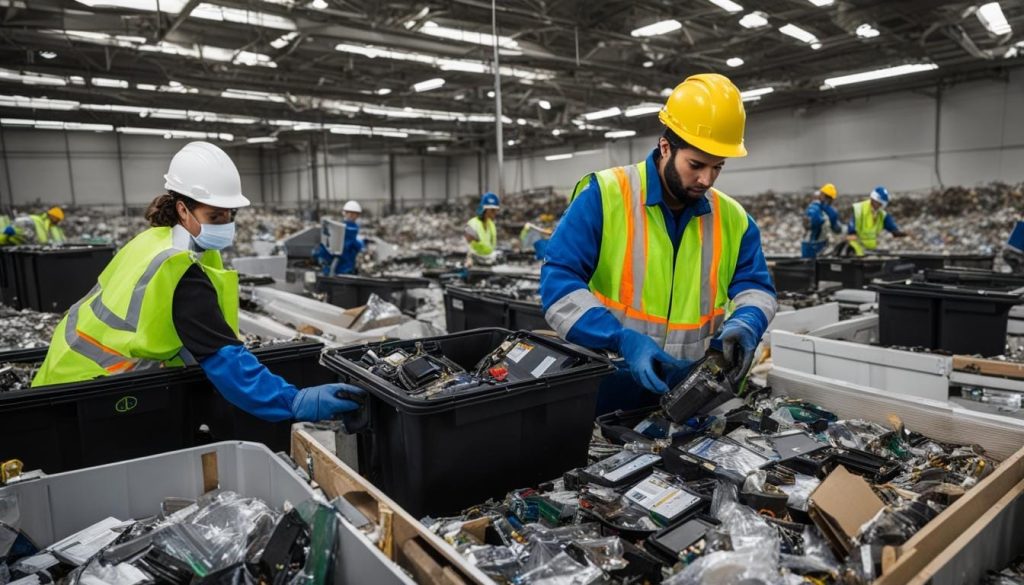In the 21st century, the proliferation of electronic devices has led to a significant increase in electronic waste, or e-waste. Posing both environmental and social challenges. As we navigate the complexities of e-waste recycling, it’s imperative to delve into the ethics of e-waste surrounding this issue. This blog explores how ethical practices in e-waste recycling are crucial for balancing environmental responsibility and social impact.
Empowering Consumers for Ethical E-waste Recycling
Consumers wield significant influence in shaping the e-waste landscape through their purchasing decisions and disposal practices. By adopting informed and sustainable consumption habits. Individuals can play a pivotal role in reducing e-waste generation and promoting ethical recycling practices. Here’s a detailed exploration of how consumers can contribute to ethical e-waste recycling:
1. Informed Purchasing Decisions
- Product Longevity: Prioritize products designed for durability and longevity over short-term trends. Look for devices with robust construction, reliable components, and warranties that guarantee extended lifecycles.
- Repairability: Opt for products that are easily repairable and upgradeable. Allowing for the replacement of individual components rather than the entire device. Support manufacturers that provide access to repair manuals, spare parts, and repair services.
- Modularity: Choose modular devices that allow for easy disassembly and replacement of components, facilitating repair, upgrading, and recycling. Modular designs promote resource efficiency and extend the lifespan of electronic devices.
2. Sustainable Manufacturing Practices
- Environmental Certification: Look for electronic products certified by reputable environmental standards, such as ENERGY STAR, EPEAT, or TCO Certified. These certifications ensure that products meet stringent environmental performance criteria, including energy efficiency, recyclability, and use of environmentally friendly materials.
- Supply Chain Transparency: Support brands that prioritize supply chain transparency and ethical sourcing practices. Seek information on the origin of raw materials, labor conditions, and environmental impact assessments to make informed purchasing decisions.
- Circular Economy Initiatives: Choose products from companies committed to circular economy principles, such as closed-loop manufacturing and product take-back programs. Circular economy initiatives aim to minimize waste and maximize resource utilization throughout the product lifecycle, from production to end-of-life disposal.
3. Proper Disposal and Recycling
- Certified Recycling Programs: Dispose of end-of-life electronics through certified recycling programs that adhere to responsible recycling practices. Look for e-waste recycling facilities certified to international standards. Such as R2 (Responsible Recycling) or e-Stewards, which ensure ethical and environmentally sound recycling processes.
- Take-back Programs: Take advantage of manufacturer or retailer take-back programs. That allows consumers to return old electronics for recycling or refurbishment. These programs promote closed-loop recycling and ensure that valuable materials are recovered and reused in new products.
- Data Security: Before recycling electronic devices. Ensure that personal and sensitive data are securely erased or destroyed to prevent unauthorized access. Utilize data-wiping software or seek assistance from certified recycling providers to safeguard privacy and prevent identity theft.
4. Consumer Advocacy and Engagement
- Educational Resources: Stay informed about e-waste issues and recycling options through educational resources. These are provided by environmental organizations, government agencies, and industry associations. Empower yourself with the knowledge to make informed decisions and advocate for sustainable e-waste management practices.
- Community Engagement: Participate in community-based initiatives. Such as e-waste collection drives, repair workshops, and electronic swap meets, to raise awareness and promote responsible e-waste recycling. Engage with local governments and businesses to advocate for policies that support e-waste diversion and recycling infrastructure development.

Understanding Electronic Waste: A Comprehensive Overview
Electronic waste, commonly referred to as e-waste, constitutes a broad spectrum of discarded electronic devices, including but not limited to smartphones, laptops, tablets, desktop computers, televisions, and household appliances. As society’s reliance on technology grows exponentially, so does the accumulation of e-waste, presenting complex challenges in terms of environmental sustainability, resource management, and public health.
The Evolution of E-waste
The proliferation of electronic devices stems from the rapid advancement of technology and the continuous introduction of newer, more advanced models into the market. With each iteration, consumers are enticed to upgrade their devices, leading to shorter product lifecycles and a steady influx of obsolete electronics. This phenomenon has contributed to the exponential growth of e-waste on a global scale, with estimates suggesting that over 50 million tons of e-waste are generated annually.
Composition of E-waste
E-waste is characterized by its diverse composition, encompassing a myriad of materials, components, and substances. While electronic devices may vary in design and functionality, they often contain common elements that pose environmental and health hazards if not properly managed. Hazardous materials commonly found in e-waste include:
- Heavy Metals: Lead, mercury, cadmium, and chromium are among the heavy metals prevalent in e-waste. These metals are known to have detrimental effects on human health and the environment, posing risks of contamination and pollution if released into the ecosystem.
- Brominated Flame Retardants: Many electronic devices contain brominated flame retardants (BFRs), which are used to reduce the risk of fire. However, BFRs are persistent organic pollutants that can bioaccumulate in the environment and have been linked to adverse health effects in humans and wildlife.
- Plastics: The casing and components of electronic devices often consist of various types of plastics, which can be challenging to recycle due to their diverse chemical compositions. Improper disposal of plastic e-waste contributes to plastic pollution in landfills and oceans, exacerbating environmental degradation.
- Rare Earth Metals: Certain electronic components, such as magnets and batteries, contain rare earth metals like neodymium, dysprosium, and lithium. These metals are essential for the functionality of electronic devices but are scarce and environmentally intensive to extract, highlighting the importance of recycling and resource conservation.
Health and Environmental Impacts
The improper handling and disposal of e-waste pose significant risks to human health and the environment. When electronic devices are discarded in landfills or incinerated, hazardous materials can leach into the soil, water, and air, contaminating ecosystems and jeopardizing public health. Exposure to toxic substances found in e-waste has been linked to a range of health problems, including respiratory issues, neurological disorders, and reproductive abnormalities.
Environmental Responsibility:
The environmental impact of e-waste extends beyond mere disposal. Improper handling of e-waste can lead to contamination of soil, water, and air, exacerbating pollution and endangering ecosystems. Ethical e-waste recycling practices prioritize environmental sustainability by promoting the reuse, refurbishment, and responsible disposal of electronic devices. Recycling e-waste not only conserves valuable resources but also reduces the energy and carbon footprint associated with manufacturing new electronics.
Social Impact:
The social implications of e-waste recycling are multifaceted. In many developing countries, informal recycling sectors often employ marginalized communities, including children, who are exposed to hazardous working conditions without adequate protective measures. Furthermore, the export of e-waste to these countries raises ethical concerns about environmental justice and equity. Addressing the social impact of e-waste recycling requires a holistic approach that prioritizes the well-being of workers and communities affected by this industry.
Regulatory Frameworks:
Governments and international organizations have implemented regulations and standards to address e-waste management and recycling. These frameworks aim to promote responsible e-waste disposal, minimize environmental pollution, and protect the health and safety of workers. However, enforcement and compliance with these regulations vary widely across regions, highlighting the need for stronger regulatory oversight and international cooperation to ensure ethical e-waste recycling practices.
Industry Practices:
The e-waste recycling industry plays a pivotal role in determining the ethical standards of e-waste management. While some companies adhere to responsible recycling practices, others prioritize profit over environmental and social considerations, leading to unethical practices such as illegal dumping and hazardous recycling methods. Ethical leadership and corporate responsibility are essential for fostering a culture of sustainability and accountability within the e-waste recycling industry.

Case Studies:
Examining real-world examples of ethical dilemmas and best practices in e-waste recycling offers valuable insights into the complexities of this issue. From companies implementing closed-loop recycling systems to communities organizing e-waste collection drives, these case studies demonstrate the potential for positive change when stakeholders collaborate to address e-waste challenges ethically.
Future Directions
Looking ahead, there is a growing recognition of the need to integrate ethics into e-waste recycling practices comprehensively. Technological innovations, such as blockchain-based traceability systems and automated sorting technologies, hold promise for enhancing transparency and accountability in the e-waste recycling supply chain. Furthermore, increasing public awareness and advocacy efforts can drive demand for ethical e-waste recycling solutions and encourage industry-wide reform.
Conclusion
Ethical considerations are paramount in e-waste recycling, where the stakes are high for the environment and society. By prioritizing environmental responsibility and social impact, stakeholders can work together to create a more sustainable and equitable future for e-waste management. Through regulatory compliance, industry best practices, consumer education, and collective action, we can strive towards a world where e-waste is managed ethically, minimizing harm to the planet and its inhabitants.
As individuals and organizations, we have a responsibility to advocate for ethical e-waste recycling practices and support initiatives that promote sustainability and social responsibility. By taking proactive steps to reduce e-waste generation, recycle responsibly, and hold industry stakeholders accountable, we can positively change the e-waste recycling landscape.

